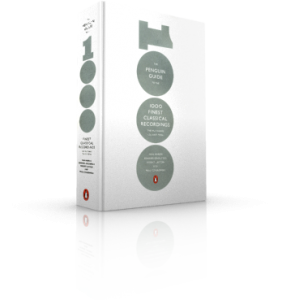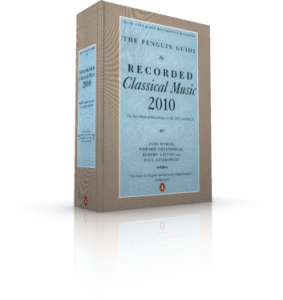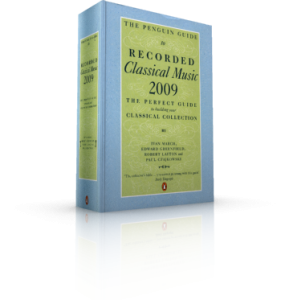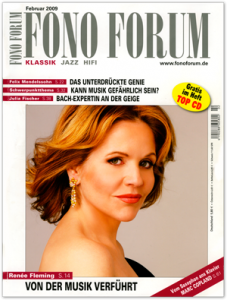THE PENGUIN GUIDE TO THE 1000 FINEST CLASSICAL RECORDINGS |
The must have CDs and DVDs
BUXHEIMER ORGELBUCH, DAS (c. 1460)
Preludes; Liturgical Melodies (based on Chorales); Transcriptions of (sacred) Motets
Oehms SACD OC 645, Joseph Kelemen (organs of St Andreaskirche, Soest-Ostönnen, and Holfkirche, Innsbruck
The Buxheimer Organ Book, of course, has nothing to do with Buxtehude but dates from two centuries before that famous composer was born and is a collection of fourteenth- and fifteenth-century repertoire. Indeed, it contains the most extensive collection of keyboard music to have survived before 1600. It uses a system of tablature notation in which the upper voice is written out and the remaining voices are written as letters below, not unlike toda‘s guitar notation. The music itself shows the transition from two-voice to three-voice counterpoint, with the occasional use of an extra fourth part, and its strongest characteristic is the use of rhythm, offering a fast, ornamented cantus moving over a calmer accompaniment. Twelve of the works included here have instructions for the use of pedal. Composers such as Johannes Ciaconia, Dunstable, Binchois and Dufay contributed.
Kelemen uses two organs, the first (whose builder is unknown), in the church os South Ostönnen which dates back to 1425. It was originally in another church but was moved to its present location in 1721/2 and has recently been restored. The second, in the Innsbruck Hofkirche, dates from 1558 and was built by Jörg Ebert. The music makes diverting listening when so well presented and splendidly recorded en SACD surround sound. The disc opens with the sonorous bell of the Ostönnen church, which dates from 1306.
THE PENGUIN GUIDE TO RECORDED CLASSICAL MUSIC 2010 |
The perfect Guide to building your classical Collection
PACHELBEL, Johann (1653 – 1706)
Aria tertia (with 6 variations); Chorale Partita: Was Gott tut, das ist wohlgeten; 6 Chorale Preludes; Ciacona in F min.; Fugues: in C & D min.; Magnificat octavi toni; Prelude in D min.; Ricerars in C & C min.; 2 Toccatas in C
****Oehms SACD OC 613. Kelemen (organs of St Petri, Erfurt-Büssleben & Klosterkirche, Pappenheim)
Every year the remarkably fine organist Joseph Kelemen sets off on an instrumental pilgrimage to discover new organs and, where possible, the associated composers. He then makes a CD for his record company, now Oehms, and phones us, later following up with the CD itself. Again this year he has been able to make his recording in surround sound, and the result is thrillingly realistic. This recording could not be more authentic, and in the robust opening Prelude in D minor, the fine Ciacona in F minor, the Aria tertia and variations and the impressive closing Toccata in F Kelemen demonstrates the organ‘s range of colour and power. When playing the CD through, the ear registers the difference as we move from the end of the Chorale Partita (track 25) to the reedy Chorale Prelude (on track 26) as Kelemen moves from Pappenheim to Büssleben.
THE PENGUIN GUIDE TO RECORDED CLASSICAL MUSIC 2009 |
The perfect Guide to building your classical Collection
KERLL, Johann Kasper (1627 – 93)
Complete Free Organ Works
M*** Oehms OC 362. Kelemen (Ededacher organ, Schlägl Abbey)
Johann Kasper Kerll, born in Adorf, Saxony, was first employed by Hapsburg Archduke Leopold Wilhelm, who sent him to Italy to study under Carissimi among others, where he almost certainly met Froberger, who was in Rome at the same time. Later he became kapellmeister at the Bavarian Court in Munich and, from 1677, court organist to Leopold I in Vienna, where the present keyboard music was almost certainly written. Joseph Kelemen has here collected his complete solo works suitable for the organ, including seven Toccatas, which are clearly influenced by Froberger, and six spirited Canzonas. But to cap the programme there is a fine Ciaccona, a spectacular Battaglia (which Kelemen makes the very most of), and the ends with a very impressive Passaglia, which shows how resourceful Kerll could be. In short, this music is highly inventive, and most enjoyable when played with such lively spontaneity. The organ itself dates from 1633 and, after frequent rebuilding over the years, was finally authentically restored, using many of the original pipes, in 1990. It has the most piquant baroque registrations and grat presence. Kelemen‘s documentation is extensive, discussing the composer, the organ and traditional performance practice. An off-the-beaten-path disc, well worth exploring.
LÜBECK, Vincent (1654 – 1740)
Chorales: Ich ruf zu dir, Herr Jesu Christ; Nun Last uns Gott den Herren; Preludes: in C; D min.; E; G; G min.; Preludes & Fugues in C min. & F min.
M*** Oehms SACD Surround Sound OC 507. Kelemen (Huss-Schnitger organ of St Cosmae et Damiani zu Stade)
The magnificent organ of St Cosmae et Damiani is the star of this disc, magnificently recorded, which in surround sound makes one think one is sitting in the church itslf. Joseph Kelemen contributes, of course, for he brings all this music fully to life, revelling in the bravura, and especially in using the pedals. This is the perfect instrument for this repertoire, for Vincent Lübeck was appointed organist at St Cosmae in 1674, although he would not have known the sound of the present instrument. The music included here has only recently come to light and it all sounds pretty marvellous in Kelemen‘s hands, with the registration consistently imaginative. The opening Preludium in C minor has a thundering pedal solo, with three fugues following, and there are more spectacular pedal solos in the Preludes in D, G minor and D minor. Contrast is provided by the Choral Prelude, Nun Last uns Gott den Herren, in which Kelemen invests the variations with piquant colouring. He is equally imaginative in the Choral fantasia, Ich ruf zu dir, Herr Jesu Christ, using echo effects in the reeds, while the closing D minor Prelude, which has one of the longest fugues in North German organ writing, ends with a virtuoso toccata. All in all, a pretty stimulating recital.
FONOFORUM KLASSIK Februar 2009
Das 17. Jahrhundert ist für die Tastenmusik so etwas wie die „kambrische Explosion“ für das Leben auf der Erde. Fünf neue Einspielungen werfen Schlaglichter auf bekannte und weniger bekannte deutsche Tastenmeister.
… Schild war ein Schüler des „norddeutschen Organistenmachers“ Sweelinck, und angesichts der oft heiteren, ungezwungenen Art des Amsterdamer Meisters mag man sich wundern, wie streng die Musik seiner Schüler oft daherkommt. Das gilt auch für Samuel Scheidt und seine monumentale „Tabulatura nova“, deren zweiten Teil Franz Raml inzwischen eingespielt hat. Auf den ersten Blick mag es schematisch wirken, dass Raml choralgebundene Musik der Orgel zuweist, alles andere dem Cembalo – Variationen, aber auch die kontrapunktischen Sätze. Gerade Letztere überzeugen aber dadurch, wie besonnen Raml die spekulative Mehrstimmigkeit entfaltet: Das „Ricercare“, das nachsinnende Forschen, kommt zu seinem Recht. Die ruhigen Tempi auch der Orgelsätze bewirken unewartete sinnliche Intensität – zumal Raml ausgezeichnete Instrumente traktiert: ein Cembalo nach G. B. Giusti und die herrliche Orgel in Tangermünde, 1624 vollendet von Franz Scherer dem Jüngeren im Erscheinungsjahr von Scheidts Opus magnum.
Ausschließlich den Orgelwerken Weckmanns ist die CD Joseph Kelemens gewidmed, eingespielt an Weckmanns späterer Wirkungsstätte, der Jakobikirche in Hamburg. In deren mächtiger Orgel von 1689/93 verbaute der Orgelbauer Arp Schnitger auch zahlreiche Register, die der 1674 gestorbene Weckmann noch gespielt haben dürfte. Ins Zentrum der Einspielung stellt Kelemen die große, halbstündige Choralbearbeitung „Es ist das Heil uns kommen her“; dazu erklingen zwei kleinere Choralbearbeitungen und sieben freie Kompositionen. Angesichts seiner Spezialisierung auf Alte Tastenmusik spielt Kelemen ganz undogmatisch, ja musikantisch locker, dabei mit kundigen Registrierungen, die dem Farbreichtum der prominenten Orgel gerecht werden.
Weniger bekannt sind die Instrumente, auf denen Kelemen ausgewählte Werke Johann Pachebels einspielte: Die Stertzung-Orgel in Erfurt-Büßleben von 1702 und die Crapp-Orgel der Klosterkirche im mittelfränkischen Pappenheim von 1722. Offenbar sucht Kelemen die Nähe von Pachelbels Wirkungsstätten Erfurt und Nürnberg. Deutlich sticht der satte Klang der Stertzing-Orgel von der schlanken Farbigkeit des fränkischen Instruments ab, auf dem sich etwa die Partita „Was Gott tut, das ist wohlgetan“ besonders elegant ausnimmt. Überhaupt inszeniert Kelemen Pachelbels Musik weniger dramatisch; mit schlichter Rhythmusgestaltung zielt er auf einen kantablen, verbindlichen Tonfall. Bei insgesamt transparentem und kräftigem Stereo-Klangbild irritiert es allerdings etwas, dass der Nachhall sich ganz auf die Mitte zurückzieht.
Friedrich Sprondel
Weckmann, Orgelwerke; Joseph Kelemen (2006); Oehms/HM CD 4260034866270 (70‘)
Pachelbel, Orgelwerke; Joseph Kelemen (2005 – 2006); Oehms/HM CD 4260034866133 (75‘)

